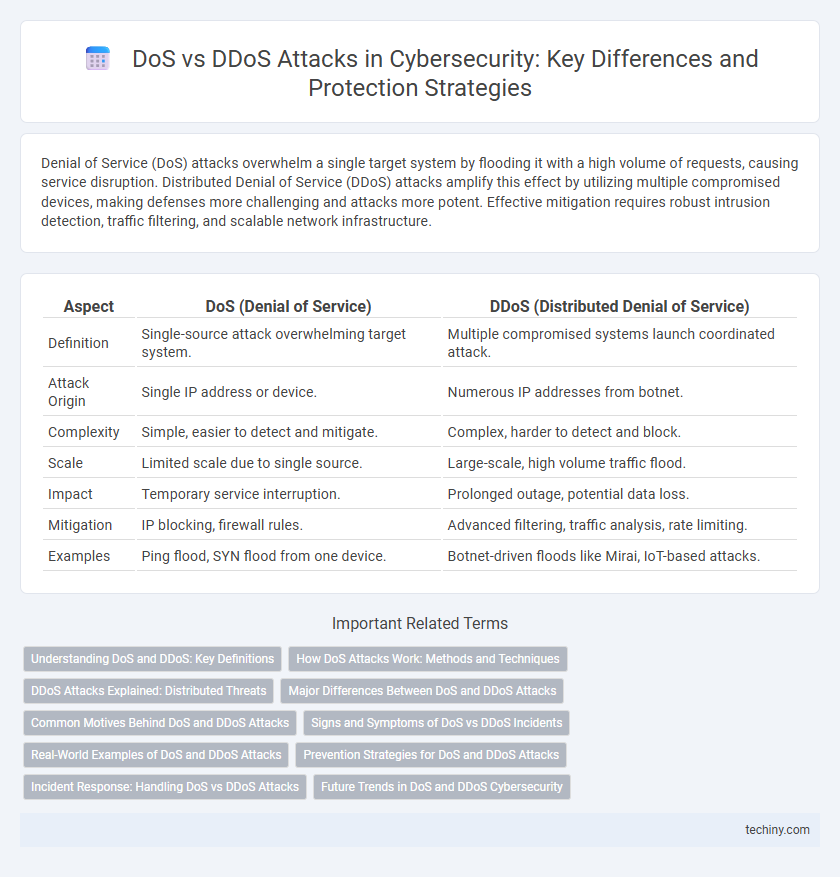Denial of Service (DoS) attacks overwhelm a single target system by flooding it with a high volume of requests, causing service disruption. Distributed Denial of Service (DDoS) attacks amplify this effect by utilizing multiple compromised devices, making defenses more challenging and attacks more potent. Effective mitigation requires robust intrusion detection, traffic filtering, and scalable network infrastructure.
Table of Comparison
| Aspect | DoS (Denial of Service) | DDoS (Distributed Denial of Service) |
|---|---|---|
| Definition | Single-source attack overwhelming target system. | Multiple compromised systems launch coordinated attack. |
| Attack Origin | Single IP address or device. | Numerous IP addresses from botnet. |
| Complexity | Simple, easier to detect and mitigate. | Complex, harder to detect and block. |
| Scale | Limited scale due to single source. | Large-scale, high volume traffic flood. |
| Impact | Temporary service interruption. | Prolonged outage, potential data loss. |
| Mitigation | IP blocking, firewall rules. | Advanced filtering, traffic analysis, rate limiting. |
| Examples | Ping flood, SYN flood from one device. | Botnet-driven floods like Mirai, IoT-based attacks. |
Understanding DoS and DDoS: Key Definitions
Denial of Service (DoS) attacks involve a single source attempting to overwhelm a target system, network, or service, causing disruption or unavailability. Distributed Denial of Service (DDoS) attacks leverage multiple compromised devices, often part of a botnet, to flood the target with traffic, amplifying the attack's scale and impact. Understanding the distinction between DoS and DDoS is crucial for implementing effective cybersecurity defenses and incident response strategies.
How DoS Attacks Work: Methods and Techniques
DoS attacks overwhelm a single target system by exhausting its resources through methods like TCP SYN flooding, ICMP echo requests, or UDP flood attacks, causing service disruption. Attackers exploit protocol vulnerabilities and manipulate network traffic flow to create congestion, rendering servers or networks unresponsive. Techniques such as application-layer attacks specifically target web applications to exhaust server capacity and impair legitimate user access.
DDoS Attacks Explained: Distributed Threats
DDoS attacks leverage multiple compromised systems, often botnets, to overwhelm a target's network, causing service disruption and downtime. Unlike DoS attacks originating from a single source, DDoS amplifies traffic volumes by distributing attack signals across numerous devices, making mitigation complex and resource-intensive. Effective defense strategies incorporate traffic filtering, rate limiting, and real-time anomaly detection to counteract the distributed nature of these cyber threats.
Major Differences Between DoS and DDoS Attacks
DoS attacks originate from a single source targeting a system to exhaust its resources and cause downtime, while DDoS attacks leverage multiple compromised devices across various locations to amplify the attack's scale and intensity. The distributed nature of DDoS attacks makes them harder to detect and mitigate compared to the more straightforward DoS attacks. Network infrastructure and cybersecurity defenses must differentiate these attack types to implement appropriate mitigation strategies effectively.
Common Motives Behind DoS and DDoS Attacks
DoS and DDoS attacks are primarily motivated by financial gain, as cybercriminals seek to extort businesses through ransom demands or disrupt competitors' operations to gain market advantage. Ideological reasons also drive attacks, with hacktivist groups targeting organizations to promote political agendas or social causes. Furthermore, cyber espionage and revenge motivate attackers aiming to damage reputations or steal sensitive information through service disruption.
Signs and Symptoms of DoS vs DDoS Incidents
Signs of a Denial of Service (DoS) attack include severe network slowdowns, unresponsive servers, and single-source traffic surges targeting specific applications or IP addresses. Distributed Denial of Service (DDoS) incidents exhibit symptoms like large-scale, multi-source traffic floods overwhelming network infrastructure, widespread service outages, and simultaneous bursts of connection attempts from geographically dispersed devices. Monitoring tools often detect distinct patterns such as repetitive connection requests in DoS attacks versus diverse traffic sources and varied attack vectors in DDoS scenarios.
Real-World Examples of DoS and DDoS Attacks
The 2016 Mirai botnet attack overwhelmed Dyn's DNS infrastructure, leading to widespread internet outages, exemplifying the devastating impact of DDoS attacks. In contrast, the 2013 Spamhaus attack targeted a single DNS provider with massive traffic, disrupting global web access and illustrating a large-scale DoS event. These real-world cases highlight the intensity gap between DoS and DDoS attacks, with DDoS leveraging multiple compromised systems to amplify disruption across critical networks.
Prevention Strategies for DoS and DDoS Attacks
Implementing rate limiting and firewall filtering effectively reduces the risk of DoS attacks by controlling traffic volume from individual IP addresses. Deploying advanced intrusion detection systems (IDS) and traffic anomaly analysis mitigates DDoS attack impacts by identifying and blocking distributed sources. Leveraging cloud-based DDoS protection services provides scalable defense by absorbing and dispersing malicious traffic before it reaches critical infrastructure.
Incident Response: Handling DoS vs DDoS Attacks
Effective incident response to DoS attacks involves identifying the offending source and implementing rate-limiting or firewall rules to block malicious traffic at the origin. In contrast, DDoS attacks require deploying advanced mitigation strategies such as traffic filtering, scrubbing centers, and leveraging Content Delivery Networks (CDNs) to absorb and disperse large attack volumes from multiple distributed sources. Rapid detection, continuous monitoring, and coordination with Internet Service Providers (ISPs) are critical in minimizing downtime and restoring service during both DoS and DDoS incidents.
Future Trends in DoS and DDoS Cybersecurity
Emerging advancements in AI-driven attack detection and automated response systems are reshaping defenses against DoS and DDoS threats. The proliferation of IoT devices and 5G networks is expected to increase attack vectors, necessitating enhanced real-time traffic analysis and adaptive filtering techniques. Cloud-based mitigation strategies and blockchain-enabled authentication protocols are gaining traction to combat the escalating complexity of distributed denial-of-service attacks in the near future.
DoS vs DDoS Infographic

 techiny.com
techiny.com